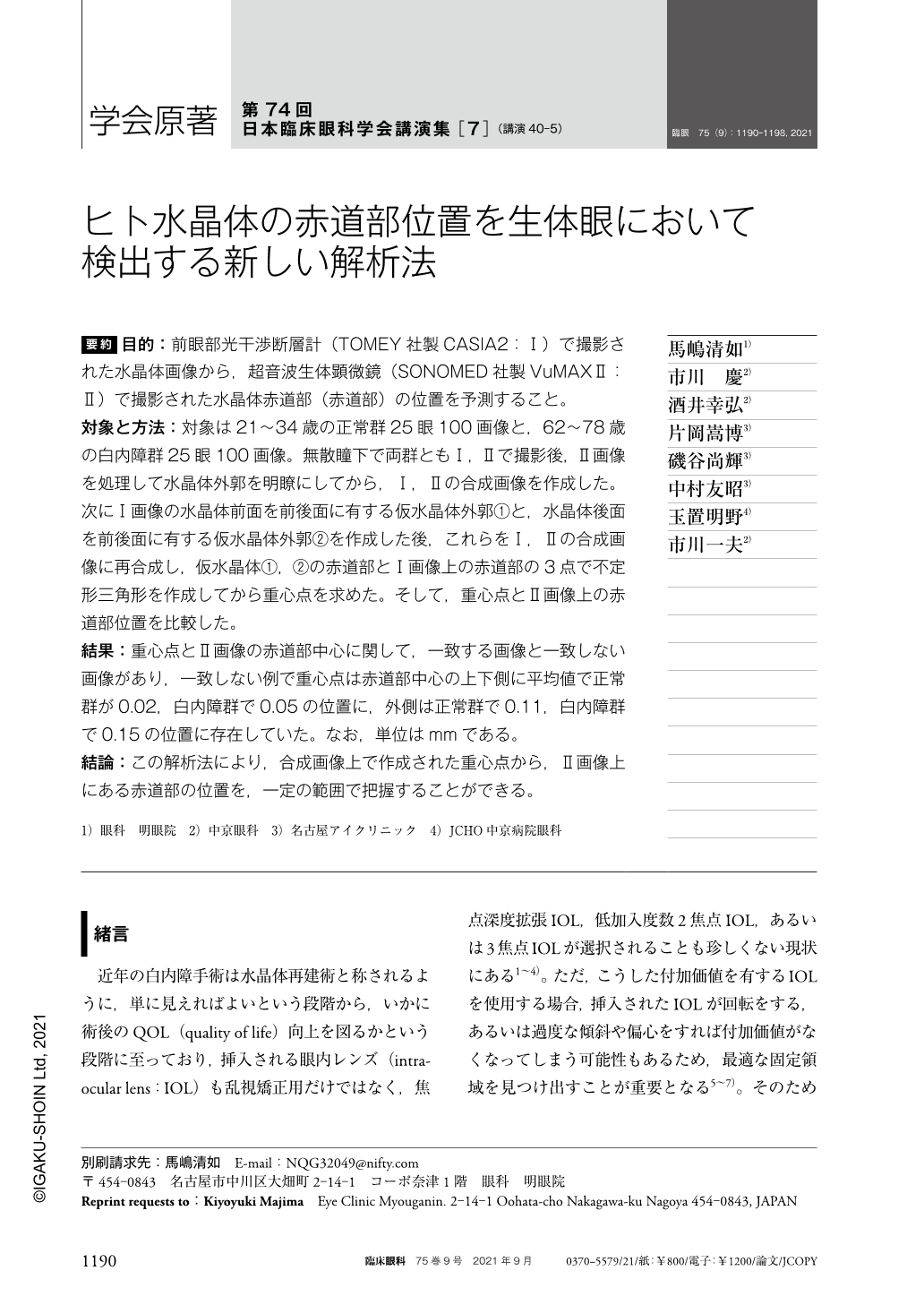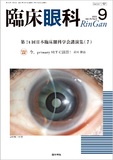Japanese
English
- 有料閲覧
- Abstract 文献概要
- 1ページ目 Look Inside
- 参考文献 Reference
要約 目的:前眼部光干渉断層計(TOMEY社製CASIA2:Ⅰ)で撮影された水晶体画像から,超音波生体顕微鏡(SONOMED社製VuMAXⅡ:Ⅱ)で撮影された水晶体赤道部(赤道部)の位置を予測すること。
対象と方法:対象は21〜34歳の正常群25眼100画像と,62〜78歳の白内障群25眼100画像。無散瞳下で両群ともⅠ,Ⅱで撮影後,Ⅱ画像を処理して水晶体外郭を明瞭にしてから,Ⅰ,Ⅱの合成画像を作成した。次にⅠ画像の水晶体前面を前後面に有する仮水晶体外郭①と,水晶体後面を前後面に有する仮水晶体外郭②を作成した後,これらをⅠ,Ⅱの合成画像に再合成し,仮水晶体①,②の赤道部とⅠ画像上の赤道部の3点で不定形三角形を作成してから重心点を求めた。そして,重心点とⅡ画像上の赤道部位置を比較した。
結果:重心点とⅡ画像の赤道部中心に関して,一致する画像と一致しない画像があり,一致しない例で重心点は赤道部中心の上下側に平均値で正常群が0.02,白内障群で0.05の位置に,外側は正常群で0.11,白内障群で0.15の位置に存在していた。なお,単位はmmである。
結論:この解析法により,合成画像上で作成された重心点から,Ⅱ画像上にある赤道部の位置を,一定の範囲で把握することができる。
Abstract Purpose:To predict the position of the equatorial region on an image(image Ⅱ)taken with an ultrasonic biomicroscope(VuMAXⅡ, SONOMD Co.Ltd)based on a crystalline lens image(image Ⅰ)taken with an anterior segment optical coherence tomography(CASIA2, TOMEY Co.Ltd).
Subjects and methods:Hundred images of 25 eyes from participants aged 21 to 34 years were included in the normal group, and 100 images of 25 eyes from participants aged 62 to 78 years were included in the cataract group. As to images Ⅰ and Ⅱ of both groups were taken, the images Ⅱ were processed to clearly define the outer lens outline, and then composite images of Ⅰ and Ⅱ were created. The position of the equatorial region on images Ⅰ and Ⅱ were compared. Following this, two pseudo-lens outer shells were created:(1)the front surface of the crystalline lens was on the front-rear surface and(2)the rear surface of the crystalline lens was on the front-rear surface of image Ⅰ. They were combined with the composite image of Ⅰ and Ⅱ. The three points, equatorial region in image Ⅰ and pseudo-lens outer shells(1)and(2), created an amorphous triangle on image Ⅰ, and the center of gravity was calculated. Furthermore, the center of gravity and the position of the equatorial region of image Ⅱ were compared.
Results:In all cases, the equatorial region in image Ⅱ was located below that of the image Ⅰ. Except the occasions that the center of gravity were consisted with the equatorial regions in image Ⅱ, the center of gravity were located from the equatorial region of images Ⅱ both superiorly and inferiorly and in a mean distance of 0.02 mm in the normal group and 0.05 mm in the cataract group. Furthermore, the center of gravity were located on outside from the equatorial region of images Ⅱ and in a mean distance of 0.11 mm and 0.15 mm in the normal and cataract groups, respectively.
Conclusion:In clinical practice, image Ⅰ is used for lens observation, but its utility is limited as the position of the equator cannot be accurately determined. Therefore, we consider the above-mentioned method will be able to overcome this shortcoming.

Copyright © 2021, Igaku-Shoin Ltd. All rights reserved.


